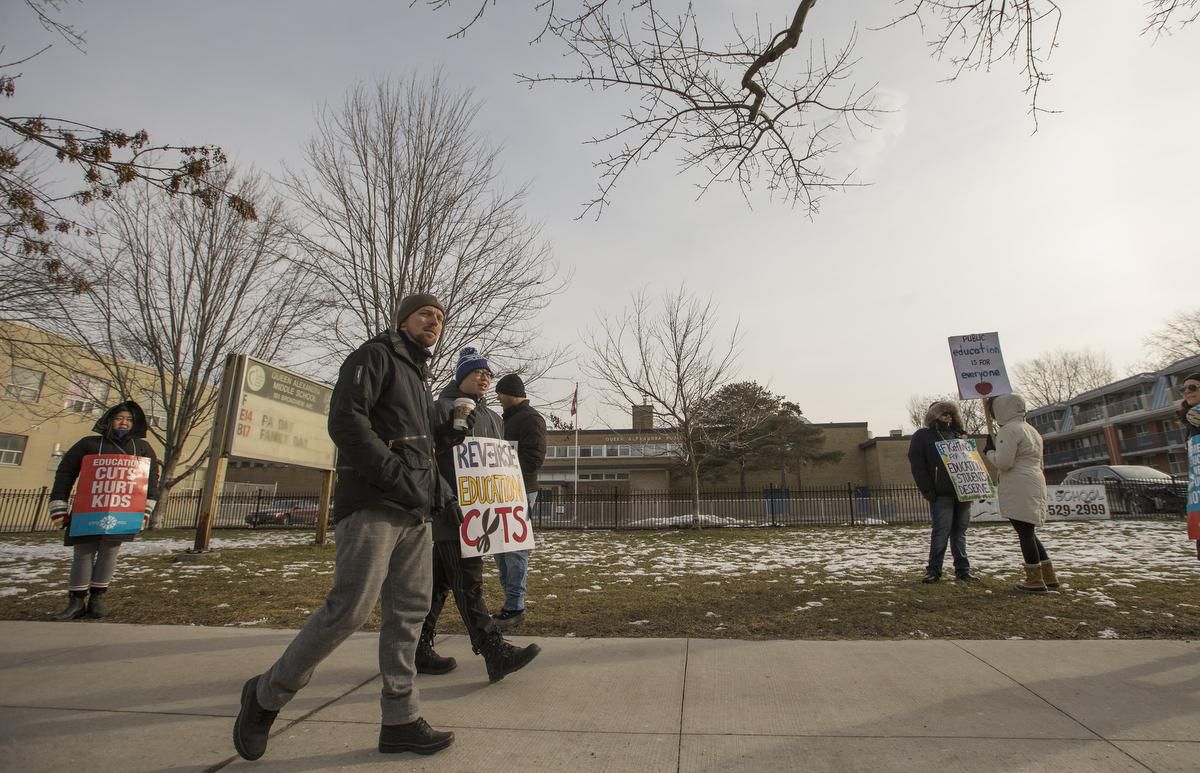Ontario’s elementary teachers plan to restart their weekly strikes after the March Break.
The union made the announcement Monday afternoon, just moments after news came that the mediator has called them back to negotiations with the provincial government.
“This government needs to come to the table this week to demonstrate their commitment to public education,” said Karen Campbell, first vice-president of the Elementary Teachers’ Federation of Ontario, adding there is great public support for her members.
The union, she added, will soon release a list with more than 800 Ontario businesses that support educators.
ETFO had been engaging in two days of strike per week — one province-wide, and one day that rotated through different boards in the province — but they had been put on hold.
Details of ETFO’s upcoming, rotating one-day strikes are to come, and the union said it will provide the required five days’ notice.
The government and ETFO will resume bargaining on Wednesday. Their last day at the table was Jan. 31.
Education Minister Stephen Lecce called on ETFO to stop its job action.
“Now that the mediator has called us back to negotiate, the time is now for the union to cease escalation and focus on negotiating a deal that keeps students in class,” Lecce said in a statement.
“While ETFO has decided to escalate their withdrawal of service, our government is squarely focused on getting a deal — a positive deal that effectively freezes classroom sizes, provides full support for special education, maintains full-day kindergarten, and ensures merit-based hiring. Our focus is on negotiating so students can remain in class as opposed to being negatively impacted by continuing escalation by the teachers’ unions.”
But Campbell, speaking to reporters at ETFO’s downtown Toronto head offices, said Lecce’s media announcements “have done nothing but obscure the fact that this government is continuing its cuts to elementary public education.”
She said a “key issue” is that more than $200 million in funding for special education has yet to be restored for 2019-20 and beyond.
“It is still nowhere near the level needed to meet the actual needs of students,” she said.
Campbell also noted per-student funding declined this year, and that funding for class size averages in Grades 4 to 8 was reduced, even though the province’s own public consultations showed no support for this.
On Monday, the province continued a fourth day of negotiations with the Ontario English Catholic Teachers’ Association and was set to resume talks with the union representing French-board teachers on Tuesday and Wednesday.
There was no word on when the Ontario Secondary School Teachers’ Federation and the province might be called back to the bargaining table by the Ministry of Labour mediator.
“While OSSTF remains willing to negotiate, we have not been invited back to the table since the minister’s press conference interrupted our exploratory talks last week,” said union president Harvey Bischof.
At Queen’s Park, Lecce was asked about the government’s move to increase class sizes in high schools from last year’s average of 22 to 23 — something he announced last week as talks with teachers had largely reached an impasse.
The government had previously said it wanted to boost classes to an average of 28, then 25. This year, the average is about 22.9.
“The increase in class sizes the government imposed this year had real consequences for students in the form of hundreds of cancelled classes and layoffs for teachers and education workers,” said New Democrat MPP Marit Stiles, her party’s education critic.
“The latest version of the Ford Conservative plan means class sizes are set to go up again next year, something the Canadian Centre for Policy Alternatives said could mean 4,000 teaching positions gone by 2023-24.”
She noted that during the government’s mass public consultations, “overwhelmingly parents, students, teachers, education workers and experts said no to higher class sizes.”
Get more of today’s top stories in your inbox
Sign up for the Star’s Morning Headlines email newsletter for a briefing of the day’s big news.
Sign Up Now
Indeed, the Ontario Public School Boards’ Association, as well as the Ontario Student Trustees’ Association — which advocates for the province’s two million public school pupils — continue to push for a return to 22.
Lecce said the government is “negotiating with one aim, and that is to get a deal that keeps every child in this province in class. That is our obligation, it is our commitment, and that’s why we’re working hard at the table.”
All four teacher unions are engaged in job action, and had been holding one-day strikes, which all had put on hold until after the March Break.



















